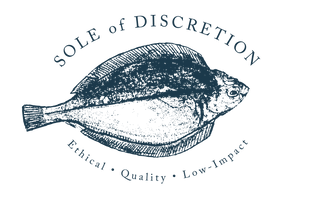Carbon Emissions and Fishing
With Climate Change top of the news items at the moment, from wildfires in Oregon, mudslides in Japan and floods in Germany and Belgium and Chinese tube lines, it might be timely to reflect on how we can reduce our carbon footprint through our food choices, so here are my thoughts on picking your way through a fish list.
One of the prime reasons for choosing to buy fish caught by the smaller, inshore boats is that they use less fuel per kilo of fish landed than an industrial trawler. When I learnt that, I was shocked – I’d always assumed that economies of scale must kick in for the larger fishing vessels, and fuel use would be one of them, but in fact it’s counter intuitive and is the exact opposite. According to research by Daniel Pauly, one of the world’s leading marine biologists at the University of British Columbia, fuel used per kilo of fish landed for human consumption by the large-scale vessels is between 5 and 20 litres, as compared to 2 to 5 litres by the small-scale vessels. This means that in the best cases, small scale vessels are 10 times more fuel efficient than the larger boats.
But even on the lower end of fuel use by the smaller boats, this is still an eye wateringly high amount of carbon burnt for so little fish – imagine a good medium sized bass, it’s around 1kg, a boat may have taken 2 litres of fuel to catch it!
The stats in the above example are global, and we’d like to say that our fishers use far less fuel, and anecdotally I’d say that that they do. However, we need to back that up and to that end we are planning on doing more research on this point through two projects – one is with the Soil Association to help quantify just how less damaging the small-scale boats can be than the industrial trawls on many levels, including seabed impact, discards and bycatch reductions to the amount of fuel consumed. Secondly, pre-covid we worked with Exeter University to compare the Life Cycle Analysis and carbon footprint of farmed salmon and our wild Alaskan salmon as of course, while we wish to ween people off environmentally damaging farmed salmon, we need to be sure the benefits aren’t outweighed by the long distances the Alaskan species have to travel (frozen, at sea).
It is well documented that the agricultural systems producing our food contribute one fifth of global man-made carbon emissions, and up to one third of all emissions if waste and transportation are factored in. But how does fishing fit in to this? A recent study published in Nature earlier this year is the first to calculate the carbon cost of bottom trawling, and the results were pretty horrifying.
Industrial scale bottom trawling, in which fishing fleets drag immense weighted nets along the ocean floor, scraping up fish, shellfish and crustaceans along with significant portions of their habitats. According to calculations conducted by the report’s 26 authors, bottom trawling is responsible for one gigaton of carbon emissions a year—a higher annual total than even (pre-pandemic) aviation emissions.
Clearly eating animal protein should be done with caution if we want to play a role in reducing our carbon footprint and relying less heavily on processed foods and eating well-reared, quality, but less, animal protein makes a good start.
I’ve not researched this hard, but a back off the envelope guide to eating less carbon emitting fish would be somewhere along these lines:
From Best to Worst:
Mussels – they are often hand gathered on ropes and there isn’t much fuel used to get to the beds
Shoaling species such as herring or anchovy from small boats, the trawl can be as short as 20 minutes, and the shoals aren’t far off the coastline, so these can be very fuel-efficient species to eat
Line caught species such as pollack and mackerel, so long as the fisher hasn’t needed to steam out far from port.
At the bottom of the list for carbon emissions, and most other environmental criteria, are dredged or trawled prawns and scallops. Avoid if you want your children to have any chance of knowing the beauty of our temperate and clement climate here at home in the British Isles.
A team from the Greenpeace ship MV Esperanza documents discarded bycatch on the deck of a Spanish flagged bottom-trawler, the Ivan Nores, in the Hatton Bank area of the North Atlantic, 410 miles north-west of Ireland. Bottom-trawling boats, the majority from EU countries, drag fishing gear weighing several tonnes across the sea bed, destroying marine wildlife and devastating life on underwater mountains - or 'seamounts'. © Greenpeace / Kate Davison - July 2021
